anth g6085

pointe shoes
rachel gershman (columbia university)
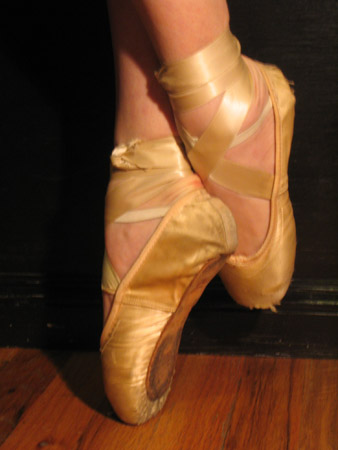
situating these pointe shoes
I’ll begin with a physical description of the ballet slippers in their current state: each shoe’s interior is canvas and the exterior is light pink satin, dirtied with use. In some places, the satin has been worn away. The soles and the toes of the shoes are made of stiff canvas to support the toe and arch of the foot wearing the pointe shoes. These pointe shoes are about 12 years old, but have not been worn in any consistent manner in around 10 or 11 years. Although the shoes are old, their worn-out, seemingly damaged character comes almost entirely from use – not age.
..
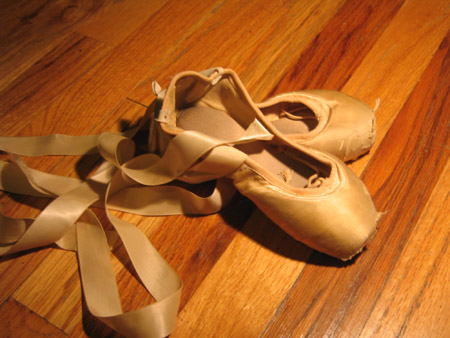
..
the pointe shoe and its essential relations
Graham Harman posits the idea that every relation between objects becomes an object in itself. (2005) Along those lines, although digressing slightly from Harman, I would like to suggest that this pointe shoe is the object that is created through the relation between a pointe shoe, a foot and a floor. Even now that the pointe shoe is not being worn by a foot or touching a floor, the material, physical evidence of its relations to both the foot and the floor have become part of the object, its materiality and its meaning. The pointe shoe is the object that it is because of those relations with other, specific objects. Without those relations, this pointe shoe would be a different object. Rather than viewing object relations solely as something that comprises and defines the pointe shoe, I see thse interactions as creating a new object: this pointe shoe as it currently exists.
This focus on the relations between objects, the way one acts on or perceives another, can be traced in various ways to Latour, Harman, Ingold, and others. Harman would note that no one entity can perceive the pointe shoe fully; the air, a spectator and a dancer each perceive the shoe in a different and incomplete way. I would agree with Harman that each of these entities is missing something in its perception of the shoe. Similarly, although I am focusing on the floor and the foot, each of these things perceives the shoe in a different, yet incomplete manner. And at the same time, the shoe’s perception of both the foot and the floor does not fully encompass the entire meaning of either of those two objects.
Bruno Latour suggests that something new is created when two objects merge. (1999) For instance, Latour might say that when a pointe shoe and a floor meet, a new object, a pointe shoe-floor, is created. In a way, I want to suggest that this pointe shoe is a shoe-floor-foot object, the result of the meeting of a shoe, foot and floor. In his theories, Latour focuses on such relations between objects, but less so, on the objects themselves. Using a Latourian model, I might also reflect on the blackbox created around a pointe shoe, and discuss the many ideas and constructions bound up in the object – such as the history of ballet and its ballerinas, changes in ballet shoe design, ideas of binding one’s foot to be beautiful, the manufacturer of this particular shoe, and so on.
However as Latour moves into a discussion of blackboxes, he loses the importance of the individual objects involved: the shoe, the foot and the floor. And I would suggest that these objects are important, because change results through the impact each has on the materiality of the others. Harman might consider this change to be simply a sensual relation between one object and another (2005), but I would argue that these sensual relations are not just the variable, and incomplete, ways in which humans and nonhumans perceive each other; these relations fundamentally change the object itself.
..
the foot
Pointe shoes are inextricably linked to the body and embodied experience. In an attempt to focus more intently on the pointe shoe itself, I will look at the relations between the pointe shoe and another object –the foot – rather than between the shoe and a human being. A particular pointe shoe is what it is because of the relationship it has with a particular foot. For example, a brand new pointe shoe is an empty shell, in a way. It comes without ribbon or elastic attached. Both of those elements must be sewn on the shoe, based on the dimensions of the foot that is to wear it. This foot then further shapes the shoe physically, through the process of “breaking it in.” The shoe stretches to fit to the shape of the foot, and becomes flexible –- and usable—only through repeated interaction with the foot. The pointe shoes about which I am writing have ceased to be in constant contact with the foot, and so, as they sat in a bag for 10 years, have become hard and unusable. It is this continuous interaction between the foot and the shoe that makes it a functional pointe shoe.
..
the floor
Just as the foot acts on the pointe shoe through the process of breaking-in, so does the floor. The pointe shoe is pressed and bent against the floor, often in somewhat violent ways, to help soften the shoe for ideal use. After this initial process, the pointe shoe continues to be shaped and changed through its interactions with the floor. Generally, each part of the shoe interacts with the floor in a particular way; this repetition of similar relations leaves behind physical, material evidence that is preserved in the shoe itself. Because the toe of the shoe is most often acting on the floor, and vice versa, that region of the shoe is most worn away. But other areas are also heavily worn, such as the heel. The sides of the shoe, for example, almost never touch the floor; in these sections, the satin is better preserved. Exactly how and where the shoe and floor perceived each other has become ingrained in what the shoe means and how it acts.
..
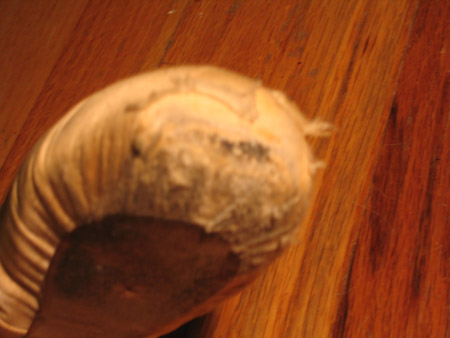 ........
........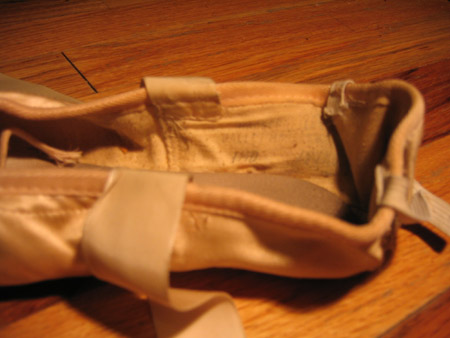
..
mediating between the foot and the floor
Yet, the shoe does not perceive the floor on its own; those worn-away spots fully depend on how the foot interacts with the floor through the shoe. The shoe is what enables the foot and the floor to interact in a specific way that would not be possible if one object were removed. The shoe enables the foot to move in ways it could not move on its own, and the foot enables the shoe to move in ways it could not move on its own (or through contact with any other “thing” that guides its movement). The “shoe-floor” object cannot exist without the “foot-shoe” object. But, although occupying an intermediary position, the shoe is still strongly shaped by the individual interactions with both the foot and the floor, as well as by the way all three are combined.
In the case of the pointe shoe in use, the foot is not only perceiving the inside of the shoe, but it is also perceiving the floor, despite the fact that it is not directly interacting with the floor. Harman cites Merleau-Ponty’s idea that for a blind man, his stick provides him with a new layer of perception. He does not perceive the stick itself; rather the stick becomes an extension of his body. (2005) Similarly, the pointe shoe becomes an extension of the foot, and allows the foot to act on and be acted on by the floor.
Not only does the shoe retain physical evidence of this relationship, but so do the floor (scuff marks) and the feet (bleeding, damaged toes). As a mediating object, however, the pointe shoe’s agency is not to blame. Rather, it is simply creating the conditions that allow the foot to damage the floor and that allow the floor to damage the foot. Only when all three objects are combined do all three objects retain the physical evidence of interaction.
..
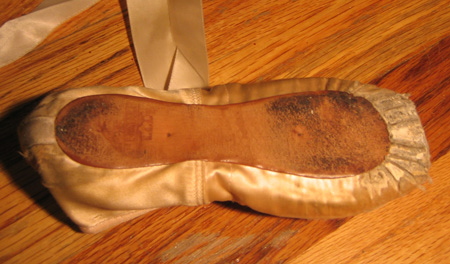
..
further discussion
Given the clear ways in which interaction with the foot and the floor impact the pointe shoe, I would argue that these pointe shoes are essentially different objects from those that just emerged from the box. These two specific, physical--one could say, sensual--interactions have changed both what the pointe shoe means and what it does. In terms of its new meaning, the outwardly evidence of its relations to the foot and the floor now mark the shoe as one that is authentic, as opposed to a brand new, stiff shoe without ribbons attached. This shoe—unlike a new one—carries legitimacy as a pointe shoe, due to its external physicality. Regarding changes in what the shoe does, it can now move and act on its surroundings in a way that it could not before it began interacting with the foot and the floor.
While trying to avoid anthropomorphizing the pointe shoes, we can apply Bourdieu’s social theory of habitus to the discussion. Considering the habitus, or the system of “structured, structuring dispositions” (1990, p.52) of the pointe shoes reinforces the idea that particular conditions of a pointe shoe’s existence influence it to interact with its environment in the way that it does. Just as an individual develops durable dispositions based on the conditions of existence it encounters, the pointe shoes develop a habitus of their own through their experiences with the foot and the floor. Bourdieu notes that habitus “ensures active presence of past experiences.”(1990, p.53) History that has become internalized, embodied and forgotten drives a person or community’s current actions and perceptions, perpetuating that past into the present.
Extending this idea to the pointe shoes, the shoe’s previous experiences and interactions with the foot and the floor, in the past, have shaped how the shoe acts in the present. Bourdieu suggests that this process of “produc[ing] history on the basis of history…makes the individual agent a world within the world.” (56) Similarly, the pointe shoes, shaped by their past, have become a world within a world, comprised of their multiple defining relations. As Tim Ingold writes, “Thinking and feeling, in Bourdieu’s account, do not go on in an interior subjective (or intersubjective) space of images and representations but in the space of people’s actual engagement in the settings of practical activity.” (2000, p.162) While I am not suggesting that pointe shoes think or feel, it is useful to consider the importance of the external space of practice and activity in the creation of meaning.
In suggesting that objects only truly interact internally through their notes, Harman seems to brush aside sensual perceptions as less important in defining the object. But I’d like to place more importance on those outwardly relations. While interactions with the foot and the floor do not change the chemical composition of the pointe shoe, and both a new and used pointe shoe are generally recognizable as “pointe shoe,” I’m suggesting that the used and unused pointe shoe are inherently different objects. And that difference stems almost entirely from the pointe shoe’s external relationships with two other specific objects – the foot and the floor.
gg
references
Bourdieu, Pierre.1990. The Logic of Practice. Stanford, CA: Stanford University Press.
Harman, Graham. 2005. Guerrilla Metaphysics. Chicago, IL: Open Court Publishing Company.
Ingold, Tim. 2000. Perception of the Environment: Essays on Livelihood, Dwelling and Skill. London, UK: Routledge.
Latour, Bruno. 1999. A Collective of Humans and Nonhumans. In Pandora’s Hope: Essays on the Reality of Science Studies. Cambridge: Harvard University Press.
..